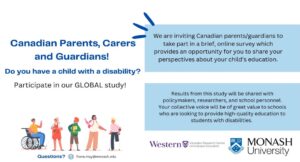|
I know what I am about to say will seem like heresy to some. Maybe even to most. But the Toronto District School Board’s initial draft of the Equity Task Force report, released in October 2017, got it right when they recommended phasing out specialty programs and optional attendance in one’s neighbourhood school (that is, students can attend a school in the system other than their neighbourhood school). It was a shock to me that the Task Force recommended this. Not because I considered it to be wrong, but because it was so unexpected that they would make such a forward-thinking recommendation. But it should have been obvious to any observer – as it was to me – that this idea would fail in an instant. And it did. Only days after the release of the draft report, TDSB pulled back on the proposal. |

I sit as one of several community representatives on the TDSB’s Special Education Advisory Committee; that is, I represent no particular agency or constituency within the disability community. Sitting as a member of SEAC allows me more access to information regarding what is happening at the Board in special education. As a person who spends a great deal of time thinking about equity issues, my lens extends to how racialized students fare by comparison to others within the special education world. Disturbingly, not very well. They are over-represented in special education classes for the disabled and under-represented in classes for the gifted. Further, I understand them to be over-represented for suspensions and expulsions, as are students with special education needs generally.
To address some of the inequities faced by racialized students in the general education population, the Director of Education has seen fit to recommend to the TDSB’s Trustees that it should end streaming of high school students beginning in grade 9 or 10. The logic behind it is sound. However, while that logic could equally apply to the “de-streaming” of students currently in special education classrooms, and at much younger ages, the Director is not recommending a robust reduction in segregated special education classrooms in the Board. This is despite the fact that the TDSB is the most segregated Board in the province, and possibly Canada; and despite the generally poor outcomes for persons with disabilities in these classrooms and the implications for racialized communities.
To be fair, TDSB is taking some steps. For example, one is the “remodel” of the “Home School Program”, a special education classroom for a half day within a student’s neighbourhood school (all other special education classes usually take a student out of their neighbourhood home school altogether). The remodel of the HSP will see those students supported within the regular general education classroom all day. For the time being, the remodel extends only to students in grades 1 to 3. This decision is backed up by the Board’s own research showing that the original HSP program has not had the hoped-for outcomes.
People are nervous. The staff are unaccustomed to this. It has not been how things have been done. TDSB has fostered a view that special education students are better serviced in “specialized classrooms” by “specialist teachers”, despite the dearth of evidence to support that view, particularly for students with disabilities. Unfortunately, special education classrooms do not reliably deliver much of what is promised beyond the smaller student to teacher ratio. They often create very disabling environments instead of enabling ones, which after all, defeats their intended purpose. It appears that the opposite approach of enabling inclusion in the regular classroom and neighbourhood school may well be the better one. Further, over-reliance on special education classrooms for the disabled is contrary to the basic legal framework we operate under, including our international obligations under the UN Convention on the Rights of Persons with Disabilities.
Admittedly, the TDSB is a big school board. It isn’t easy to turn around such a big ship and change such an entrenched culture. Understandably, “fighting” the many constituencies who support one form of specialized program, classroom, or school or another is a drain on everyone and does not feel very productive. Following the release of the revised Equity Task Force recommendations in December 2017, this January the Director released his response. As expected, the revised report did not include phasing out of specialized programming or optional attendance. The Director made a number of good proposals to address some of the concerns for marginalized students, including “exclusion” of students with disabilities (the report avoids the term “segregation”). However, it is my view that the proposals made so far will be insufficient to result in the changes needed to better support all students in their neighborhood schools and avoid a flight from them. A significant shift in resources and training is needed and this is not what is currently proposed. It appears all existing specialized school options will continue “as usual”. These in turn will continue to act as a barrier to improving the regular classroom and the neighbourhood school.
As I have proposed to the Board, in the long run, if we genuinely want to see equity in the system, we need to properly resource and fund neighbourhood schools and use specialised classrooms only if and when they are truly warranted, based on evidence and data. We need to give people a reason to stay in their neighbourhood schools and phase out the over-reliance on specialized classes and schools at TDSB.
Author
Paula Boutis sits as a community member of the Toronto District School Board’s Special Education Advisory Committee. She is also an active member of Integration Action for Inclusion. A lawyer by training, she current sits as an adjudicator on one of the province’s appeal boards. She also has two wonderful young daughters, one of whom is a student in the TDSB. She can be reached by email at pboutis.seac@gmail.com

